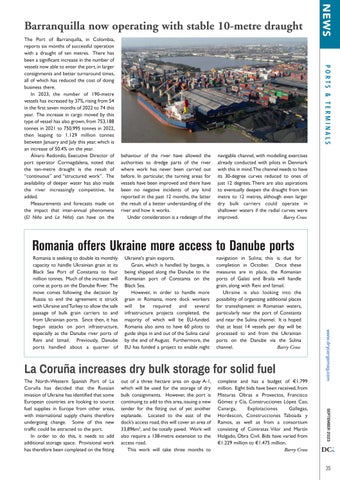PORTS & TERMINALS
The Port of Barranquilla, in Colombia, reports six months of successful operation with a draught of ten metres. There has been a significant increase in the number of vessels now able to enter the port, in larger consignments and better turnaround times, all of which has reduced the cost of doing business there. In 2023, the number of 190-metre vessels has increased by 37%, rising from 54 in the first seven months of 2022 to 74 this year. The increase in cargo moved by this type of vessel has also grown, from 753,188 tonnes in 2021 to 750,995 tonnes in 2022, then leaping to 1.129 million tonnes between January and July this year, which is an increase of 50.4% on the year. Álvaro Redondo, Executive Director of port operator Cormagdalena, noted that the ten-metre draught is the result of “continuous” and “structured work”. The availability of deeper water has also made the river increasingly competitive, he added. Measurements and forecasts made on the impact that inter-annual phenomena (El Niño and La Niña) can have on the
NEWS
Barranquilla now operating with stable 10-metre draught
behaviour of the river have allowed the authorities to dredge parts of the river where work has never been carried out before. In particular, the turning areas for vessels have been improved and there have been no negative incidents of any kind reported in the past 12 months, the latter the result of a better understanding of the river and how it works. Under consideration is a redesign of the
navigable channel, with modelling exercises already conducted with pilots in Denmark with this in mind.The channel needs to have its 30-degree curves reduced to ones of just 12 degrees. There are also aspirations to eventually deepen the draught from ten metre to 12 metres, although even larger dry bulk carriers could operate in shallower waters if the radial curves were improved. Barry Cross
Romania offers Ukraine more access to Danube ports Ukraine's grain exports. Grain, which is handled by barges, is being shipped along the Danube to the Romanian port of Constanta on the Black Sea. However, in order to handle more grain in Romania, more dock workers will be required and several infrastructure projects completed, the majority of which will be EU-funded. Romania also aims to have 60 pilots to guide ships in and out of the Sulina canal by the end of August. Furthermore, the EU has funded a project to enable night
navigation in Sulina; this is due for completion in October. Once these measures are in place, the Romanian ports of Galati and Braila will handle grain, along with Reni and Izmail. Ukraine is also looking into the possibility of organizing additional places for transshipment in Romanian waters, particularly near the port of Constanta and near the Sulina channel. It is hoped that at least 14 vessels per day will be processed to and from the Ukrainian ports on the Danube via the Sulina channel. Barry Cross
La Coruña increases dry bulk storage for solid fuel out of a three hectare area on quay A-1, which will be used for the storage of dry bulk consignments. However, the port is continuing to add to this area, issuing a new tender for the fitting out of yet another esplanade. Located to the east of the dock’s access road, this will cover an area of 33,896m², and be totally paved. Work will also require a 138-metre extension to the access road. This work will take three months to
complete and has a budget of €1.799 million. Eight bids have been received, from Misturas Obras e Proxectos, Francisco Gómez y Cía, Construcciones López Cao, Canarga, Explotaciones Gallegas, Hordescon, Construcciones Taboada y Ramos, as well as from a consortium consisting of Contratas Vilor and Martín Holgado, Obra Civil. Bids have varied from €1.229 million to €1.475 million. Barry Cross
SEPTEMBER 2023
The North-Western Spanish Port of La Coruña has decided that the Russian invasion of Ukraine has identified that some European countries are looking to source fuel supplies in Europe from other areas, with international supply chains therefore undergoing change. Some of this new traffic could be attracted to the port. In order to do this, it needs to add additional storage space. Provisional work has therefore been completed on the fitting
www.drycargomag.com
Romania is seeking to double its monthly capacity to handle Ukrainian grain at its Black Sea Port of Constanta to four million tonnes. Much of the increase will come at ports on the Danube River. The move comes following the decision by Russia to end the agreement it struck with Ukraine and Turkey to allow the safe passage of bulk grain carriers to and from Ukrainian ports. Since then, it has begun attacks on port infrastructure, especially as the Danube river ports of Reni and Izmail. Previously, Danube ports handled about a quarter of
DCi 35







































